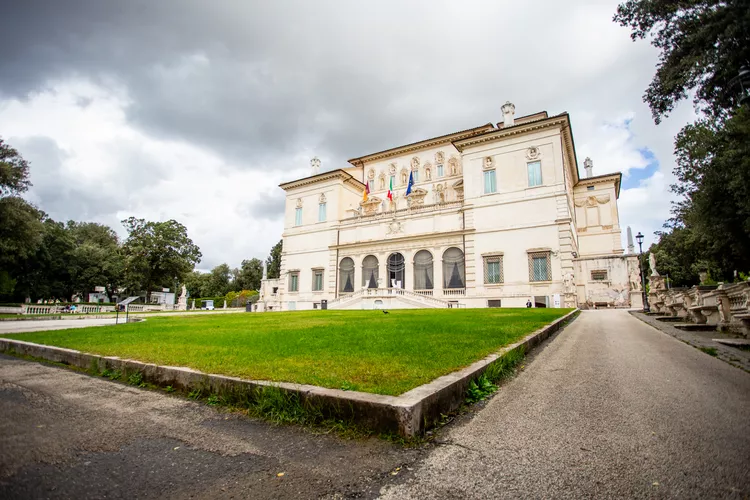Summary
Piazzale Scipione Borghese, 5, 00197 Roma RM, Italy
Phone +39 06 841 3979
Location
Located on Pincio Hill, the Borghese Gallery, also known as Galleria Borghese, stands out as one of the top museums in Rome. This architectural marvel resides within the exquisitely frescoed Villa Borghese estate, a 17th-century structure consisting of 20 opulent rooms filled with invaluable marble sculptures and an eclectic array of masterpieces from notable artists since the 16th century. Importantly, the term Villa Borghese refers to the expansive public park encompassing various Borghese palaces, while the primary Borghese palace is now referred to as the Galleria Borghese.
History
The inception of the Villa Borghese and its enchanting gardens can be traced back to 1613, commissioned by Cardinal Scipione Borghese, the nephew of Pope Paul V. This residence served dual purposes for the Cardinal: a venue for lavish entertainment and a showcase for his burgeoning art and antiquities collection. Noteworthy acquisitions include contributions from Baroque sculptor Bernini and illustrious painters such as Caravaggio, Raphael, and Titian.
In 1808, the Cardinal’s heir, Camillo Borghese (who was married to Paolina Bonaparte), faced the unfortunate circumstance of relinquishing a significant portion of classical sculptures to his brother-in-law, Napoleon, which now grace the antiquities wing of the Louvre.
Bernini Masterworks in the Collection
The Galleria Borghese proudly houses an extraordinary sculpture collection, particularly on its ground floor, showcasing some of Bernini’s most acclaimed works, notably completed when he was merely in his early 20s:
- Apollo and Daphne (1624): This mesmerizing sculpture captures the nymph Daphne’s transformation into a laurel tree as she evades Apollo’s abduction, portraying remarkable dynamism in marble.
- The Rape of Proserpina (1621): This piece exemplifies Bernini’s brilliance in rendering marble to appear as pliable as human skin, depicting Hades’ hand gripping Proserpina as she struggles to escape.
- David (1624): A striking representation of the biblical David, poised to launch a slingshot at Goliath, with the sculptor believed to have portrayed his own likeness in David’s face.
- Bust of Scipione Borghese (1632): A significant patron, Scipione Borghese’s bust was sculpted by Bernini, who later created a second version due to a marble defect, with both featured in the museum.
Other Highlights at Galleria Borghese
Pauline Bonaparte as Venus Victrix (1805-1808): Renowned artist Antonio Canova crafted this remarkable sculpture representing a reclining, semi-nude Paolina Bonaparte, commissioned by her husband, Camillo Borghese, to revive the Roman custom of depicting mortals as gods.
Greatness in Oil: The gallery’s first floor is adorned with paintings, offering masterpieces from Raphael’s Deposition and Lady with a Unicorn, Titian’s The Scourging of Christ and Sacred and Profane Love, alongside Caravaggio’s creations including The Boy with a Basket of Fruit and Saint Jerome Writing.
Ancient Treasures: The main floor showcases an impressive array of antiquities from the 1st to the 3rd centuries AD, featuring remarkable artifacts such as a Roman bronze from 150 BC and extraordinary mosaics from the 4th century.
How to Visit Galleria Borghese
Visitors to the museum are limited to 360 guests at any given time, with each visit capped at two hours. Reservations are essential through the Galleria Borghese website. For those planning to visit during peak seasons, it is advisable to secure reservations well in advance to ensure access to the collection. A private guided tour can enhance your experience, and options are available through reputable providers.
Roma Pass holders can benefit from free or discounted entry but must still book an entry time by calling +39 06 32810.
Hours: Tuesday through Sunday, from 9 AM to 7 PM (last entry at 5 PM). Closed Mondays, December 25, and January 1.
Admission: Adults: €15; EU citizens under 18: €8.50. Disabled visitors only pay the €2 booking charge; children aged 5 and under are free. (Prices reflect 2018 rates and include a mandatory €2 reservation fee, with potential increases during special exhibitions.)
Location: Galleria Borghese, Piazzale Scipione Borghese 5, located in the Villa Borghese Gardens.
How to Get There: By Bus: multiple routes including 5, 19, 52, 63, 86, and others; By Metro: Line A (red) to the Spagna stop.
Nearby Attractions
Villa Borghese Gardens: This expansive 200-acre park features lakes, meadows, villas, temples, children’s playgrounds, a zoo, an amphitheater, a cinema, and horse riding facilities.
The Galleria Nazionale d’Arte Moderna: Located within the Villa Borghese grounds, this gallery showcases 19th and 20th-century paintings, emphasizing the works of Italian artists.
Muse Nazionale di Villa Giulia: Located in another magnificent Borghese villa, it boasts Italy’s largest collection of Etruscan antiquities, shedding light on this enigmatic pre-Roman civilization.
Piazza del Popolo: Situated at the base of Pincio Hill, this square is one of Rome’s largest and most significant urban spaces.





